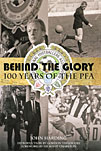 100 Years of the PFA
100 Years of the PFA
by John Harding
Breedon, £18.99
Reviewed by Joyce Woolridge
From WSC 269 July 2009
Trade union history is not the easiest of material to turn into an engrossing read. Chronicling the history of the Players’ Union brings an additional challenge, that, in some quarters at least, there is little sympathy for the PFA and its purported defence of irresponsible, greedy players “holding the game to ransom”. Harding’s update of his earlier pioneering PFA official history For The Good of the Game is an unashamedly polemical and timely reminder of why the PFA exists and what it has done for professional football. Written with the same clarity and skill as Harding’s classic biography of Billy Meredith, Football Wizard, and the underrated Living to Play, this book is yet another timely addition to what could be thought of as an ongoing “elevatory project” within football which seeks to counter the stereotype of the “footballer as a thick-headed yokel who needs constant discipline and cannot be trusted to manage his own affairs” as maverick 1970s PFA Chair Derek Dougan put it.
This compelling and fascinating analysis demonstrates how from 1900 to 1971 professional footballers remained, as Jimmy Guthrie, the union’s firebrand socialist Scottish chairman famously announced to the 1955 TUC conference, “the last bonded men in Britain”. At the turn of the century footballers found themselves squeezed between the prejudices of the FA, a patrician group which despised professionalism, and the Football League, businessmen and the like, which, unable to stomach the idea of sharing out gate receipts, opted instead for a wage cap and the retain-and-transfer system. Those who set up the first incarnations of the players’ union were further hamstrung by the “special” nature of the footballer’s contract, which meant that it was not bound by industrial legislation.
That the union survived, Behind The Glory reveals, is partly a testament to the tenacity of stalwarts such as Billy Meredith and Charlie Roberts, as well as later chairmen like Guthrie. It was about more than seeking an end to the injustices of the retain-and-transfer system. Union officials exhausted themselves travelling the country doling out small but crucial payments to widows, bailing men out of prison, paying removal costs, replacing furniture or paying hospital bills. The latter part of the book has much to say about the educational and welfare work of the PFA, and its vital role as a safety net in a profession in which there is a huge wastage rate. The book ends with a very interesting discussion of the deep ironies of Gordon Taylor’s dilemma when faced with the implications of the Bosman ruling which would give footballers the unlimited freedom of contract about which Meredith dreamed, but which might threaten the survival of the 92 League clubs.
Harding has an eye for the enlivening quirky story amidst the historical detail – a wealth of information which, as a football historian myself, I know is impossible to find elsewhere. Dougan’s involvement in the abortive Hall of Fame scheme is one particularly enjoyable example. The illustrations are excellent, including facsimile newspaper clippings, memos and magazine features. Football history rarely gets better than this and it is essential reading for those who want to understand the modern game.